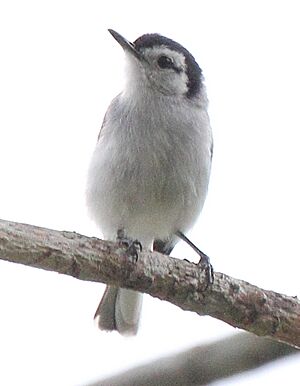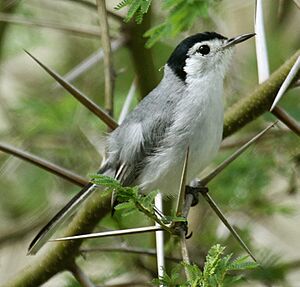Tropical gnatcatcher facts for kids
Quick facts for kids Tropical gnatcatcher |
|
|---|---|
 |
|
| Conservation status | |
| Scientific classification |
The tropical gnatcatcher (Polioptila plumbea) is a small, active songbird that eats insects. It lives in many parts of northern South America. This bird used to be considered the same species as the white-browed gnatcatcher.
Contents
About the Tropical Gnatcatcher
The tropical gnatcatcher was officially described in 1788 by a German scientist named Johann Friedrich Gmelin. He gave it the scientific name Todus plumbeus. The word plumbeus is Latin for "lead-coloured," which describes its grey color.
Later, in 1855, an English zoologist named Philip Sclater placed this bird in a new group called Polioptila. This group now includes 17 different types of gnatcatchers.
Scientists used to think the tropical gnatcatcher and the white-browed gnatcatcher (Polioptila bilineata) were the same species. But a study in 2018 showed they are actually different species.
There are seven main types, or subspecies, of the tropical gnatcatcher:
- P. p. maior Hellmayr, 1900 – found in northern Peru
- P. p. anteocularis Hellmayr, 1900 – found in central Colombia
- P. p. plumbiceps Lawrence, 1865 – found in northeast and east Colombia, and northern Venezuela
- P. p. innotata Hellmayr, 1901 – found from east Colombia to central Guyana and northern Brazil
- P. p. plumbea (Gmelin, JF, 1788) – found in Suriname, French Guiana, and northern Brazil
- P. p. atricapilla (Swainson, 1831) – found in northeast Brazil
- P. p. parvirostris Sharpe, 1885 – found in east Ecuador, northeast Peru, and northwest Brazil
What Does It Look Like?
Adult tropical gnatcatchers are about 10 to 12 cm (3.9–4.7 in) long. They weigh about 6 to 8 g (0.21–0.28 oz). Like other gnatcatchers, they are small birds with a long, thin beak. They also have a long tail that they often hold upright.
Their top feathers are grey, and their belly feathers are whitish. The middle feathers of their tail are black, while the outer ones are white. This makes the tail look black from above and white from below. They also have a white patch on their wings.
Male birds of the main group have a black cap that goes just below their eyes. Females in this group have a grey cap, the same color as their back. Some females might have a small, irregular black patch behind their eye. This patch is very clear on females of the atricapilla type from northeastern Brazil.
The tropical gnatcatcher makes a thin, buzzing gezzz sound. Its song is a trilled swee see see si si si su su. The exact sound of their calls and songs can be different depending on where they live.
Where It Lives and What It Does
The main group of tropical gnatcatchers lives from northeastern Brazil, across the Amazon Basin, and north to the Guianas, northern Venezuela, and northern Colombia. The other groups live in different parts of South and Central America. For example, the Marañón gnatcatcher only lives in the Marañón River valley in northern Peru.
These birds live in many different types of wooded areas. This includes dry woodlands and humid forests. They usually live in low areas, below 1,000 m (3,300 ft) high. However, the maior type can be found at higher altitudes, from 200 to 2,700 m (660–8,860 ft).
In thick, humid forests, they often stay high up in the treetops. But in more open areas, you might see them closer to the ground. Tropical gnatcatchers eat spiders, their eggs, beetles, caterpillars, and other insects. They pick these off twigs and leaves. They usually move around alone or in pairs. They often join groups of different bird species that are feeding together.
Reproduction and Life Cycle
The tropical gnatcatcher builds a small, cup-shaped nest. It looks a bit like a hummingbird's nest. They build it from plant fibers, about 6.5 to 28 ft (2.0–8.5 m) high on a tree branch. The female lays two or three white eggs with brown spots in May and June.
These birds are quite curious and not very afraid of people. This behavior can make them easy targets for predators. Even small mammals like the common marmoset can raid their nests. This might happen more often in the dry season when fruits are harder to find. The parent birds try to protect their babies, but sometimes it's not enough.
Conservation Status
Overall, the tropical gnatcatcher is common and found in many places. Because of this, groups like BirdLife International and IUCN say it is a species of "least concern." This means it is not currently at high risk of disappearing.
In the Amazon, these birds prefer more open habitats. So, they might even benefit from some deforestation if some trees are left standing. The Marañón gnatcatcher is still common, but it lives in a small area where a lot of its habitat is being destroyed. Some other types of gnatcatchers that live in very small areas might be at risk.



